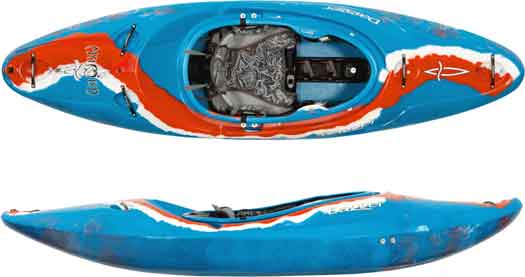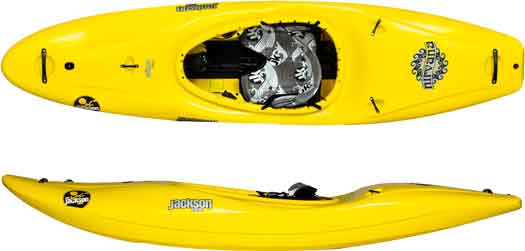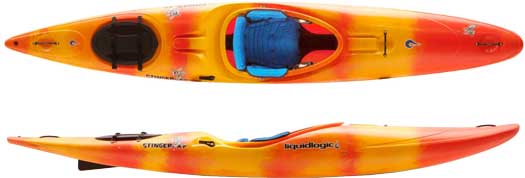Kayak Types
There is a huge range of kayaks for most activities on the water. But firstly, one obvious question, what is the difference between a canoe and a kayak? In both types of boat you sit facing forwards and you use a paddle to propel the boat forwards.
- Canoe
- A boat that you sit (usually raised) or kneel. The paddle is single bladed.
- Kayak
- A boat that you sit on a low seat. The paddle is double bladed.
Kayaks themselves have evolved into a very wide array of designs to fit various activities. One clear distinction between all of the numerous designs is for the type of water the kayak is designed for. Whitewater kayaks are designed to be easy to maneuver around rocks on rapids on moving water, while flat water kayaks are designed around a longer thinner shape to assist moving in a straight line.
Flat Water Kayaks
Roughly speaking, these can be divided into two main categories, sit in and sit on top (SoT) kayaks with surf skis fitting somewhere in the middle.
Sit-in Kayaks
- Recreational Kayak
-
Recreational kayaks are very stable and durable with large, often fully open, cockpits. They are designed for playing around close to shore on gentle lakes and rivers. They tend to lack features like rudders and hatches.
- Sea Kayak
-
Being longer, skinnier boats than recreational kayaks, sea kayaks travel faster and track straighter but lose some of their primary stability in the process. Their cockpit design allows users to use sprayskirt to keep water out and also have hatches that allow you to store gear in (mostly) waterproof hatches.
The Tiderace Pace 17 Tour (pictured) is a higher performance composite sea kayak. Composite boats tend to be lighter and more slender than plastic boats with a significant speed difference of 1-2 kph give or take but they have less primary stability (more tippy).

- Length:
- 5.22 m (17’1″)
- Width:
- 53 cm
- Weight:
- 23.5 kg
- Capacity:
- 223 L
The Prijon Kodiak is a plastic sea kayak that I have used on many trips either by choice (Culgoa, Murrumbidgee) or for logistical reasons (Murray). The 5.18 m (17’) length was sometimes tricky in smaller creeks where a crossover could be a better choice, albeit you would struggle packing enough supplies for remote trips without food drops.

- Length:
- 5.18 m (17’)
- Width:
- 59 cm
- Weight:
- 28 kg
- Capacity:
- 150 kg
Sea Kayaks are also known as Touring or Ocean Kayaks.
- Racing boats
-
Surfskis are usually included when talking about racing kayaks, but the International Canoe Federation (ICF) K series of boats are usually sit-in while surfskis are SoT / open cockpits.
The Epic K1 XL (pictured) is one of the ICF K1 kayaks that weights a fraction of weight of a sea kayak and is much narrower.

- Length:
- 5.20 m (17')
- Width:
- 40.6 cm
- Weight:
- 10.5 kg
- Capacity:
- 76 to 94 kg
There are a number of modular and inflatable kayaks that allow for easy storage and transport. The performance of these are improving every year and could be an option depending on your needs.
Sit-on-top Kayaks (SoT)
These are very stable kayaks that you either sit on top or sit in a very open cockpit. The hull is designed to be fairly flat and wide. They have small holes called scupper holes that go right through the kayak allowing any water to flow through. Great for beginners and people looking for stability while doing other actions such as fishing, etc.
Surfskis
Surfskis have very long, narrow kayaks that are built for racing with high speed and straight line performance. They have an open SoT cockpit and a self-bailer (scupper holes). Very similar to racing kayaks where the boundaries between the two are blurring slightly.
The Epic V14 Elite (pictured) is a longer performance surfski.

- Length:
- 6.40 m (21')
- Width:
- 42.9 cm
- Weight:
- 10.4 Kg
- Capacity:
- 136 kg
Whitewater Boats
Packrafts
A packraft is a raft that is lightweight and can be carried in a pack. Know as a raft as these are flat inflatable boats that look like miniature whitewater rafts, but most will use a kayaking paddle rather than a canoe paddle or rowing oar. This technically makes these inflatable kayaks that can have an open or closed cockpit.
Whitewater Kayaks
In general there are four main types of whitewater kayaks, the fourth being a hybrid design between flat and whitewater kayaks.
- Play Boats / Freestyle Boats (less than 2m /6.5 ft)
-
A very short, wide, planing-hull (flat-bottomed) boat with low volume for surfing and aerial tricks on standing waves and in hydraulic holes.
Squirt boats have even lower volume so that they sink below the eddy lines and are an extreme version of play boats for doing tricks. Free Running boats have a hybrid mix between play boats and creek boats to assist bridging flatter sections.

The Jackson Kayak Rockstar (pictured) is a good example of a play boat:
- Length:
- 1.85m (6' 1")
- Width:
- 69 cm
- Weight:
- 15.4 kg (large)
- Volume:
- 262 L
- Creek Boats (2.1 - 2.75m / 7 - 9 ft)
-
A medium-length, high-volume boat with blunt ends, specialized for hard whitewater that includes steep creeks and waterfalls. These are designed to assist the paddler clearing the bow from the water, an important part of boofing large falls and holes.
The Dagger Mamba Creek 7.6 (pictured) is a good example of a creek boat:

- Length:
- 2.31m (7' 7")
- Width:
- 65 cm
- Weight:
- 20 kg (large)
- Volume:
- 242 L
This model was retired in 2021. The Code MD is its replacement.
- River runners (2.3 - 2.75m / 7.5 - 9 ft)
-
A longer, faster, high-volume boat, specialized for easier whitewater rapids and for higher speed on flatwater sections. These are very similar in design to creek boats, but with less volume and slightly sleeker profile.
The Jackson Kayak Nirvana (pictured) is a good example of a river runner:

- Length:
- 2.85m (9' 4")
- Width:
- 70 cm
- Weight:
- 23.1 kg (large)
- Volume:
- 367 L
- Crossovers (2.75m plus / 9+ ft)
-
Crossovers that bridges the gap between river runners and expedition sea kayaks. This enables paddlers to navigate easier whitewater sections while carrying camping gear for extended trips. They get many features from both sea kayaks and river runners. They generally have a waterproof hatch for storage but lack deck rigging that can be a safety hazard in whitewater. Some may have skegs (a drop down fin under the kayak) to assist with tracking in a straight line.
The Liquidlogic Stinger XP (pictured) is a good example of a river runner:

- Length:
- 3.79 m (12' 5")
- Width:
- 62 cm
- Weight:
- 22 kg (large)
- Volume:
- 379 L
Also known as Long boats, Allrounders, Touring or Trecking boats.
Slalom Kayaks are a speciality flat-hulled low volume whitewater kayaks designed for the sport of Canoe slalom where the competitors kayak through a course of hanging downstream or upstream gates on rapids.
Canoe Polo Kayaks have many of the features of whitewater kayaks for fast, easy handling and turning capabilities in the pool.

